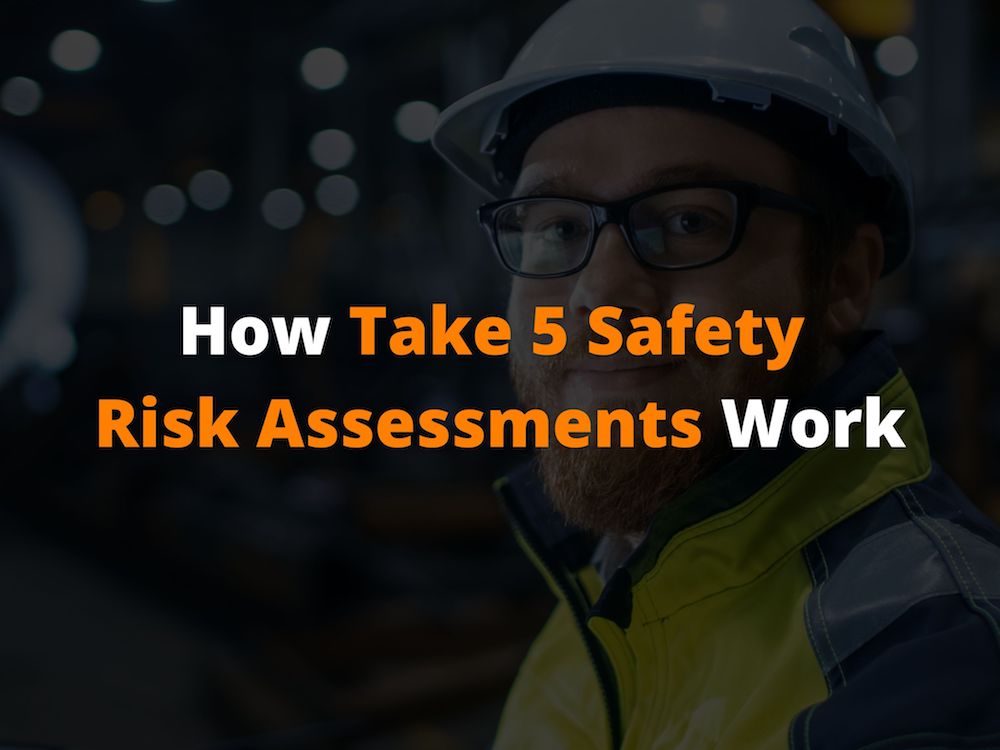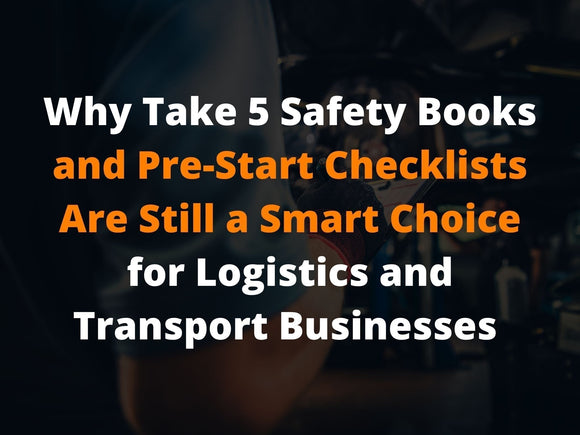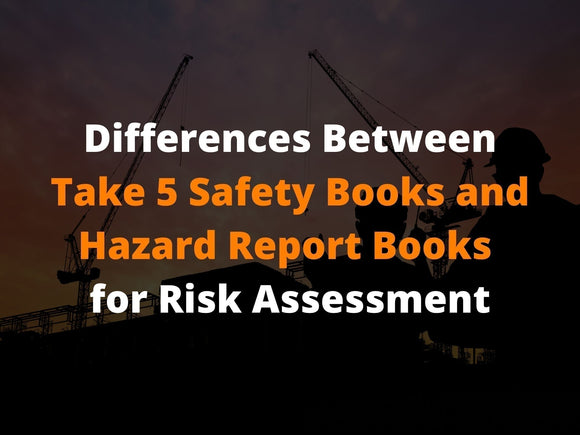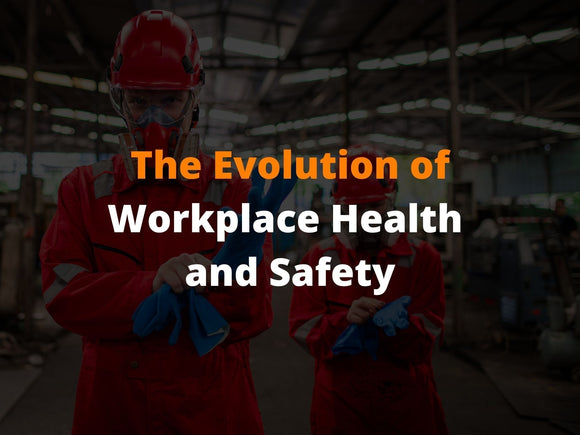
How Take 5 Safety Risk Assessments Work
Every employee has the right to their safety and wellbeing when in the workplace, which extends to their ability to do their job without compromising their health. Fortunately, the Australian government supports this, and enforces laws and policies that ensure employers cultivate a safe working environment.
When implementing safe work practices, it’s always best done when it’s seen as a partnership between the business and its employees. Working as a team allows employees to feel confident in identifying and managing potential risks that they may be exposed to in their roles. By creating awareness and open communication, employees and managers can work together in creating a safe working environment.
The Take 5 Safety Risk Assessment is a great way to implement this strategy, and is commonly used in sectors such as mining, manufacturing, and construction sectors. Here’s an overview on why it's so effective.
The Importance of Workplace Health and Safety

The main goal of Workplace health and safety (WHS), more commonly known as Occupational Health and Safety (OH/S) in Australia, is to enable its workers to undertake their work without compromising their safety and welfare. In Australia, WHS promotes a prevention-focused strategy that aims to reduce the occurrence of accidents, injuries, and diseases as opposed to how to manage them when they happen.
Your workplace is not limited to the four corners of the company office. The workplace can also be any mobile vehicle such as cars, trucks, machinery and equipment. As long as you perform a task for the company, that area is considered your workplace.
As well as this, WHS isn’t just relevant to employers and employees. Businesses are required to provide a safe space for everyone including clients, suppliers, visitors, and any workforce within the premises. As a result, the installation of safety equipment (and the implementation of safety practices) is critical.
Safe Work Practices
A Risk Assessment is one of the foundational steps in securing the safety, health, and well being of everyone in the workplace. It is a well-structured process to consistently identify existing and future hazards, evaluate the associated risks, and implement plans to remove or reduce the risks.
What is the purpose of a Risk Assessment?:
The main goals of a risk assessment are:
- IDENTIFY: To be able to correctly identify the health hazards and safety risks present or may exist within the working premise.
- CONTROL: To be able to implement control measures that could remove or reduce the risks and associated adverse effects
- EVALUATE: To be able to evaluate the effectiveness and sustainability of the currently in action control and mitigation measures
- IMPROVE: To be able to improve the current strategy by placing additional safety measures and instrument (if necessary)
What are the Benefits of a Risk Assessment:
 Conducting risk assessments in your workplace impacts positively for both workers and businesses. Here are some notable benefits of implementing Risk Assessment into the workplace:
Conducting risk assessments in your workplace impacts positively for both workers and businesses. Here are some notable benefits of implementing Risk Assessment into the workplace:
- It promotes awareness among management, colleagues, and employees.
- It creates and nurtures a healthier working environment for the company.
- It prevents the occurrence of accidents and injuries.
- It prepares your employees on how to act in the unlikely event something goes wrong.
- It saves the company a significant amount of money from possible legal fines, compensations, and hospital bills that may result from accidents.
When should I do a Risk Assessment?
Ensuring the health, safety, and welfare of your people is a continuous process. Risk assessments require regular review, evaluation, and improvement because hazards and risks never stay constant. This can be regularly done by incorporating Risk Assessment Books such as the Take 5 Safety Book in your risk management strategy. This allows you to easily manage or eliminate risks.
To make sure that your company’s safety policies and practices are being adhered to, it’s important that risk assessments are conducted on a regular basis. However, the following circumstances may prompt immediate planning and risk assessment:
- New equipment, machinery, or mobile vehicle
- A new job description that hasn’t previously been assessed
- A change in current government law, policies, and guidelines
- When an accident or near-miss injury happens
How do I do Risk Assessment?
The four major steps in conducting a Risk Assessment in your workplace are:
- Step 1: Identify potential health hazards and safety risks
- Step 2: Identify the person (or group of people) at risk
- Step 3: Establish and implement control measures
- Step 4: Assess and improve the efficiency of your control measures
Step 1: Identify potential health hazards and safety risks
Every risk assessment procedure starts by understanding the existing and future risks and hazards within the workplace. This also helps pinpoint the cause (or source) of the identified hazards.
You can conduct this step by:
- Thoroughly inspecting the working area.
- Going over records of previous accidents and injuries associated with the area.
- Checking the manufacturer’s recommendations and instructions.
- Consulting your employees, safety and health representatives, and other experts.
The commonly identified hazards include physical, chemical, biological, ergonomic, and psychological factors.
Step 2: Identify the person (or group of people) at risk
After identifying the health hazards and safety risks associated with your working environment, managers should then:
- Identify the people who are at risk
- The possible effects of the risk
- The likelihood of exposure to the risk
- The severity of harm the exposure may cause
Step 3: Establish and implement control measures
By taking into consideration the information you have collected from the previous steps, you must be able to formulate effective and appropriate control measures and plan of action. The strategy must be able to:
- Eliminate the risk completely, or;
- Reduce the likelihood of exposure to the risk, or;
- Mitigate the harmful effects of the risk to people.
Step 4: Assess and improve the efficiency of your control measures
Carefully study the effects of your risk management strategies to your employees, to the existing risks, and to the company (as a whole). If you end up with negative effects like increased work pressure, reported accidents and near misses, then you have to re-evaluate your strategy. Improve the lacking parts by using additional resources.
Risk management programs should always undergo regular review and assessment to ensure that it remains updated, effective, and reliable.

Determining the Level of Risk in Workplace
Size of Business Operations
The level of risk in your work environment depends on the size, nature, and sophistication of your operations.
- SMALL: Small businesses tend to have simpler and lighter risks which can be addressed by straightforward and correct judgments.
- MEDIUM: On the other hand, medium-sized companies with limited operations or production may have moderate to high levels of risk. Their risk assessment requires extensive research and discussion regarding their equipment and techniques.
- LARGE: Companies with large and more complex operations typically have the highest level of risk. They generally use more sophisticated pieces of machinery, complex processing, and oftentimes harmful chemicals. For these reasons, the law requires them to conduct an in-depth risk assessment that takes into consideration, studies, permits, and expert advice.
The Hazard Risk Rating Table
Regardless of the size of the company, the Hazard Risk Rating Table found in a safety book such as our Take 5 Safety Book guides you through the level of each identifiable risk. The level of risk is calculated using a consequence rating (i.e. how severe is the potential harm?), and the likelihood rating (i.e. how likely will the hazard occur?). Once this risk is calculated:
- LOW RISK: The tradesperson in charge agrees with the proposed control/s.
- MEDIUM RISK: The workplace supervisor agrees with the proposed control/s.
- HIGH RISK: The workplace manager agrees with the proposed control/s.
Using Take 5 Safety Books for your Risk Assessment
If you want to highlight the importance of health and safety in the workplace, as well as make it simple to implement and adopt - UniPrint’s Take 5 Safety resources can do just that.
As Australia’s leading designers and suppliers of safety books, we ensure our books can be easily incorporated into your workplace safety measures. All our Take 5 Safety Books are compliant, easy to use, portable, and durable. Everything your employees need to conduct their Risk Assessment is available in one pocket-sized book. If you would like to incorporate any company specific information or designs, you’ll be happy to know we can even design custom safety books to meet your exact needs.




